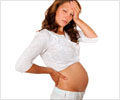- Exposure to herpes simplex virus-2 (HSV-2) during pregnancy increases the risk of autism spectrum disorder (ASD) in the offspring.
- The risk of ASD was higher if exposure to infection occurred during early pregnancy when the fetal nervous system undergoes rapid development.
- Infection leads to activation of the maternal immune system, which is associated with long-term developmental and behavioral problems in offspring.
"We believe the mother's immune response to HSV-2 could be disrupting fetal central nervous system development, raising risk for autism," says lead author Milada Mahic, a post-doctoral research scientist with the Center for Infection and Immunity and the Norwegian Institute of Public Health.
The risk is not due to direct infection of the fetus because such infections are typically fatal.
The primary or reactivation of infection in mothers with inflammation in close proximity to the womb, leads to neuro-developmental outcomes in children.
Link Between Pregnancy and Risk for Autism
The scientists wanted to examine the link between maternal infection and risk for autism, focusing on five pathogens known collectively as ToRCH agents- Toxoplasma gondii, rubella virus, cytomegalovirus, and herpes simplex viruses type 1 and 2.Blood samples were collected from 412 mothers of children diagnosed with ASD and 463 mothers of children without ASD enrolled in the Autism Birth Cohort (ABC) Study overseen by the Norwegian Institute of Public Health.
Findings of the Study
The results showed that the risk for ASD was related to high levels of antibodies to HSV-2.This link was only evident in samples of blood taken at 18 weeks of pregnancy and not at birth, indicating that the risk is higher if exposure to infection occurs during early pregnancy when the fetal nervous system undergoes rapid development.
Around 13% of mothers in the study tested positive for anti-HSV-2 antibodies at mid-pregnancy. Among them, only 12% reported having HSV lesions before pregnancy or during the first trimester. This indicated that most infections were asymptomatic.
Previous research had indicated that activation of the maternal immune system due to infection, during early-to-mid-pregnancy is associated with long-term developmental and behavioral problems in offspring.
In the study, the effect of anti-HSV-2 antibodies on risk for ASD was only seen in females, not males.
This could be because the number of females with ASD in the ABC Study is small and although autism is more common in males, there is a lack of evidence to conclude that the effect is sex-specific.
Further research will explore the importance of screening and suppression of HSV-2 infection during pregnancy.
"The cause or causes of most cases of autism are unknown," says senior author W. Ian Lipkin, director of the Center for Infection and Immunity. "But evidence suggests a role for both genetic and environmental factors. Our work suggests that inflammation and immune activation may contribute to risk. Herpes simplex virus-2 could be one of any number of infectious agents involved."
The findings appear in mSphere, a journal of the American Society for Microbiology.
Herpes Infection
Herpes infection can be due to either herpes simplex virus type 1 (HSV-1) or herpes simplex virus type 2 (HSV-2).HSV-1 is also known as oral herpes, which is mainly transmitted by oral to oral contact and it causes infection in or around the mouth.
HSV-2, also known as genital herpes is a highly contagious and lifelong infection usually spread through sex. It causes infection in the genital or anal area.
In America, 1 in 5 women carries the infection and 1 in 6 people aged 14-49 years have genital herpes.
The HSV-2 virus lies dormant in nerve cells after an initial outbreak. As the body develops resistance to the virus, the frequency of flare-ups diminishes.
Around 417 million people aged 15-49 (11%) worldwide have a HSV-2 infection.
Africa had the highest prevalence of HSV-2 infection at 31.5%, followed by the Americas at 14.4%.
Women are more prone to infection with HSV-2 than men as sexual transmission of HSV is more efficient from men to women than from women to men. In 2012, it was estimated that 267 million women and 150 million men were living with the infection.
This infection is often asymptomatic, or has mild symptoms that go unrecognized.
Common symptoms include one or more genital or anal blisters or open sores called ulcers, fever, body aches, and swollen lymph nodes.
References:
- Herpes simplex virus - (http://www.who.int/mediacentre/factsheets/fs400/en/)
- Genital Herpes - (https://www.cdc.gov/std/herpes/)
- Genital Herpes - CDC Fact Sheet - (https://www.cdc.gov/std/herpes/stdfact-herpes.htm)
Source-Medindia















